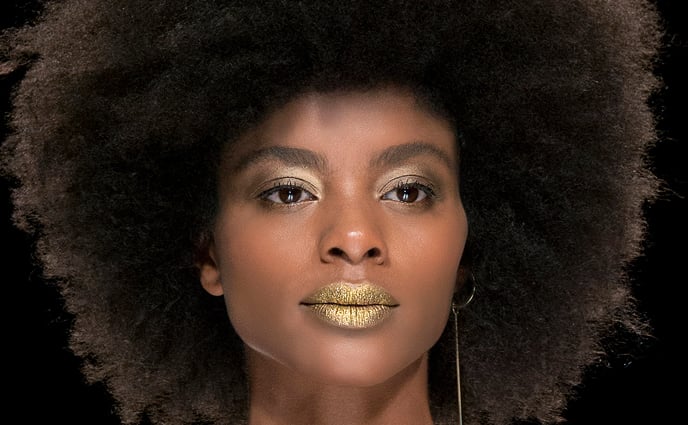On the street, we call it chicken skin. But in the dermatologist's office, they call it Keratosis Pilaris (KP) -- pronounced "Pie-LAIR-is," like the "pie" you eat and the "air" you breathe. Odds are you're familiar with this skin condition: KP consists of those little red bumps that commonly speckle the back of the arms and thighs, and it effects a whopping 40 percent of the population. Though it's not a dangerous or painful condition, KP is an international enemy purely for its stubbornness -- medical science has yet to find a cure.
So what causes KP, exactly? "It's a thickening of the upper layer of skin over each hair follicle," explains NYC Dermatologist and Founder of BeautyRx Skincare Dr. Neal Schultz, MD. "Each bump is made of the same buildup of dead skin cells that causes clogged pores, acne and dullness." With KP, dead cells made of keratin accumulate at the hair follicle, because the intercellular glue holding them together isn't dissolving like it should.
Like acne, KP can be hormonal, and it's most common among teens and young adults. "We think genetics is at play, too," says Dr. Rebecca Kazin, MD, of the Johns Hopkins Department of Dermatology. "It's people who are predisposed to sensitive skin or eczema. But most grow out of it in their 30s and 40s."
Still, for the perpetually chicken-skinned among us (myself included), the hope of "growing out of it" isn't enough. That's why we've put together this essential handbook of every derm-approved treatment available. "With KP, treatment is a process of evolution, not revolution," explains Schultz. So, even though there's no instant fix, find here the most effective moisturizes, chemical exfoliators and more for finally kicking KP's ass.
Image via Imaxtree
So what causes KP, exactly? "It's a thickening of the upper layer of skin over each hair follicle," explains NYC Dermatologist and Founder of BeautyRx Skincare Dr. Neal Schultz, MD. "Each bump is made of the same buildup of dead skin cells that causes clogged pores, acne and dullness." With KP, dead cells made of keratin accumulate at the hair follicle, because the intercellular glue holding them together isn't dissolving like it should.
Like acne, KP can be hormonal, and it's most common among teens and young adults. "We think genetics is at play, too," says Dr. Rebecca Kazin, MD, of the Johns Hopkins Department of Dermatology. "It's people who are predisposed to sensitive skin or eczema. But most grow out of it in their 30s and 40s."
Still, for the perpetually chicken-skinned among us (myself included), the hope of "growing out of it" isn't enough. That's why we've put together this essential handbook of every derm-approved treatment available. "With KP, treatment is a process of evolution, not revolution," explains Schultz. So, even though there's no instant fix, find here the most effective moisturizes, chemical exfoliators and more for finally kicking KP's ass.
Image via Imaxtree
What It Is: For treating KP, Schultz says that no-frills moisturizers are a good place to start. "These aren't fixing the problem structurally, but they will soften the hard, bumpy skin," he says. Go for one that's fragrance-free, so you don't further irritate the skin, and apply twice per day. Kazin notes, "Good lotions come in a tube or a tub," while cautioning that pump lotions are often watered down and less effective. The dermatologists recommend Eucerin Calming Cream, $8, which contains urea -- an intensive moisturizing ingredient. Looking to go all-natural? Try Burt's Bees Fragrance Free Shea Butter & Vitamin E Body Lotion, $8.
Who Should Use It: Everyone with KP can benefit from moisturizing regularly, but it won't be enough for everyone. This treatment alone is best suited to mild cases.
Pro Tip: To supplement, dermatologist Dr. Debra Jaliman, MD, recommends sleeping with a humidifier. This will add even more moisture to the skin. "It's also important to use gentle fragrance-free soaps and cleansers in the shower," she says. (Try Dove Sensitive Skin Unscented Beauty Bar, $1.79 or Cetaphil Gentle Skin Cleanser, $10.79).
Who Should Use It: Everyone with KP can benefit from moisturizing regularly, but it won't be enough for everyone. This treatment alone is best suited to mild cases.
Pro Tip: To supplement, dermatologist Dr. Debra Jaliman, MD, recommends sleeping with a humidifier. This will add even more moisture to the skin. "It's also important to use gentle fragrance-free soaps and cleansers in the shower," she says. (Try Dove Sensitive Skin Unscented Beauty Bar, $1.79 or Cetaphil Gentle Skin Cleanser, $10.79).
What It Is: Physical exfoliators slough off dead skin and smooth out the outermost layer of those raised, red bumps. "Physical exfoliation only targets the top of the buildup," Schultz clarifies. But if you're looking for a natural and affordable treatment, this can work in the short term. Exfoliate with a body buffer, loofah or organic body scrub. Schultz and Jaliman also recommend using a sonic cleansing system, such as Clarisonic PLUS Face & Body Sonic Cleansing System, $180. The different brush heads allow you to treat the face and body in a gentle or deep exfoliating way.
Who Should Use It: If your KP comes with irritation (aka, pink or red skin between the bumps), it's best to steer clear of physical exfoliators. Otherwise, most skin types can benefit.
Who Should Use It: If your KP comes with irritation (aka, pink or red skin between the bumps), it's best to steer clear of physical exfoliators. Otherwise, most skin types can benefit.
What It Is: Lactic acid is a mild chemical exfoliator, which dissolves the keratin that makes up those pesky KP bumps from the inside out. The most-recommended OTC lactic acid treatment is AmLactin Moisturizing Body Lotion, $14.99
Who Should Use It: Since the molecules in lactic acid don't penetrate the skin as deeply as other chemical exfoliators, these treatments are excellent for sensitive or breakout-prone skin. They're also recommended for pregnant women, who want to avoid salicylic acid-based products.
Pro Tip: If you have irritation-prone skin, but AmLactin isn't doing the trick, skip to a prescription-strength lactic acid medication.
Who Should Use It: Since the molecules in lactic acid don't penetrate the skin as deeply as other chemical exfoliators, these treatments are excellent for sensitive or breakout-prone skin. They're also recommended for pregnant women, who want to avoid salicylic acid-based products.
Pro Tip: If you have irritation-prone skin, but AmLactin isn't doing the trick, skip to a prescription-strength lactic acid medication.
What It Is: Salicylic acid (SA) is a mainstay acne treatment for its ability to exfoliate and turn over dead cells quickly. The skin that forms a KP bump is similar to a pimple (albeit thicker); thus, SA-based creams and cleansers are effective and widely used for treating KP. (Try CeraVe SA Renewing Lotion, $14.99).
Who Should Use It: Those who experience both KP and acne can especially benefit from SA treatments. They're also worth trying if alpha hydroxy acids, such as lactic and glycolic acids, don't work for you.
Who Should Use It: Those who experience both KP and acne can especially benefit from SA treatments. They're also worth trying if alpha hydroxy acids, such as lactic and glycolic acids, don't work for you.









